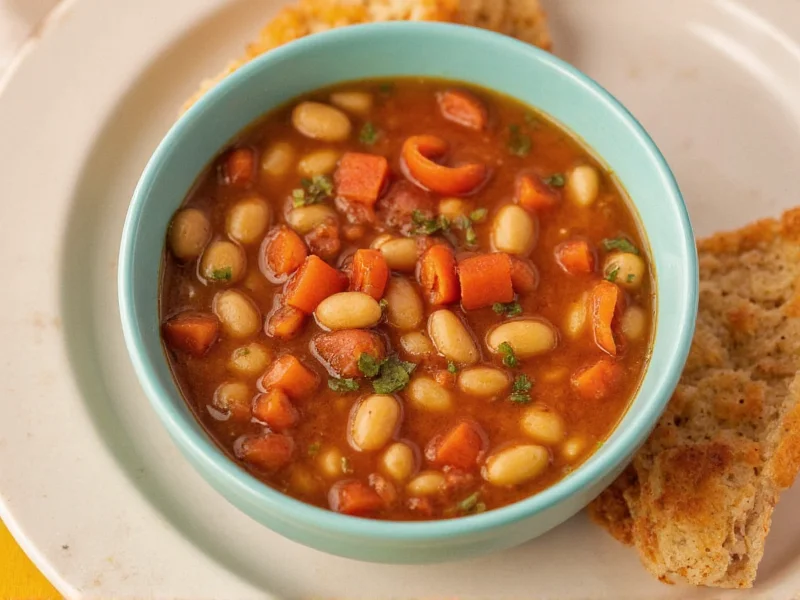Understanding the Reality of 16 Bean Soup
The term "16 bean soup" creates a common misconception. No traditional recipe uses precisely 16 distinct bean varieties. Instead, this label represents a robust blend of multiple legumes designed to deliver diverse textures, flavors, and nutritional benefits. Commercial soup mixes adopted this name for marketing appeal, suggesting exceptional variety and completeness.
Historically, multi-bean soups originated from resourceful cooking traditions where available dried legumes were combined to create nourishing meals. During economic hardships like the Great Depression, bean soups became staples due to their affordability, shelf stability, and nutritional density. The "16 bean" concept evolved as food manufacturers packaged these traditional blends for modern consumers.
Nutritional Powerhouse: Why Multi-Bean Soups Shine
Combining multiple bean varieties creates a nutritional profile superior to single-bean soups. Each legume contributes unique amino acids, creating a more complete protein source. The fiber diversity supports different aspects of digestive health, while the vitamin and mineral spectrum becomes broader with each additional bean type.
| Bean Type | Protein (per cup) | Fiber (per cup) | Key Nutrients |
|---|---|---|---|
| Black Beans | 15g | 15g | Folate, Iron, Magnesium |
| Kidney Beans | 13g | 13g | Potassium, Iron, Vitamin B6 |
| Lentils | 18g | 16g | Folate, Iron, Manganese |
| Chickpeas | 15g | 12g | Folate, Iron, Phosphorus |
This nutritional synergy makes multi-bean soups particularly valuable for vegetarians and vegans seeking complete protein sources. The complex carbohydrates provide sustained energy release, making 16 bean soup recipes excellent for maintaining stable blood sugar levels.
Typical Beans in a 16 Bean Soup Mix
While exact combinations vary, most commercial and homemade versions include these core components:
- Common Beans: Navy, Pinto, Kidney, Black, Great Northern
- Larger Beans: Lima, Cannellini, Fava
- Small Legumes: Green and Brown Lentils, Split Peas
- Specialty Beans: Anasazi, Calypso, Yellow Eye (less common but sometimes included)
When creating your own homemade 16 bean soup from scratch, consider bean cooking times. Larger beans like limas and chickpeas require longer cooking than smaller lentils and split peas. Proper sorting and soaking prevent uneven texture in your final dish.
Perfecting Your 16 Bean Soup Recipe
Creating an exceptional 16 bean soup requires attention to preparation details that many quick recipes overlook. Follow these professional techniques for optimal results:
Essential Preparation Steps
- Sort and rinse: Carefully examine beans for debris and rinse thoroughly
- Strategic soaking: Soak larger beans separately from smaller legumes (8-12 hours)
- Layered cooking: Add beans in stages based on required cooking time
- Acid timing: Add tomatoes or vinegar only after beans are tender
- Salt strategy: Add salt midway through cooking for best texture
Flavor Building Techniques
Professional chefs enhance 16 bean soup flavor through these methods:
- Create a flavor base with onions, celery, and carrots sautéed in olive oil
- Add smoked meat (ham hock or turkey leg) for depth in non-vegetarian versions
- Incorporate umami boosters like tomato paste or dried mushrooms
- Finish with fresh herbs and a splash of quality vinegar
- Allow soup to rest overnight for flavors to meld completely
Adapting 16 Bean Soup for Dietary Needs
One advantage of customizable multi-bean soups is their adaptability to various dietary requirements:
Vegetarian and Vegan Adaptations
Replace meat-based broths with vegetable stock and use smoked paprika or liquid smoke for depth. Add nutritional yeast for cheesy notes without dairy. For protein enhancement, include quinoa during the last 15 minutes of cooking.
Gluten-Free Considerations
Naturally gluten-free, 16 bean soup makes an excellent option for gluten-sensitive individuals. Verify that any pre-made broth or seasoning blends are certified gluten-free. Thicken with pureed beans rather than flour-based roux.
Low-Sodium Versions
Use no-salt-added beans and create your own broth to control sodium. Enhance flavor with garlic, herbs, lemon zest, and vinegar instead of salt. Add a small amount of seaweed like kombu during cooking for natural mineral richness.
Avoiding Common 16 Bean Soup Mistakes
Even experienced cooks encounter issues with multi-bean soups. Understanding these pitfalls ensures success:
- Undercooked beans: Different beans require varying cooking times—add them sequentially
- Mushy texture: Avoid overcooking smaller legumes by adding them later
- Flat flavor: Build layers of flavor with proper sautéing and seasoning timing
- Gas production: Change soaking water several times and add kombu while cooking
- Separation: Blend a portion of the soup to create natural thickness without flour
Storage and Reheating Best Practices
Proper storage maintains quality and safety of your homemade 16 bean soup:
- Cool soup completely before refrigerating (within 2 hours of cooking)
- Store in airtight containers for up to 5 days in the refrigerator
- Freeze in portion-sized containers for up to 6 months
- Reheat gently on the stove with a splash of water to restore consistency
- Never repeatedly freeze and thaw the same portion
Interestingly, 16 bean soup often tastes better the second day as flavors continue to meld. The starches stabilize, creating a richer texture without becoming gluey.
Exploring Global Variations of Multi-Bean Soups
While "16 bean soup" is primarily a North American commercial concept, cultures worldwide have their own multi-bean soup traditions:
- Italy: Pasta e fagioli combines cannellini beans with small pasta
- Brazil: Feijoada uses black beans with various meats
- France: Cassoulet features white beans with duck or sausage
- Mexico: Caldo de frijol blends multiple beans with epazote herb
These international variations demonstrate how combining multiple legumes creates culinary traditions valued across cultures for both nutrition and flavor complexity.











 浙公网安备
33010002000092号
浙公网安备
33010002000092号 浙B2-20120091-4
浙B2-20120091-4